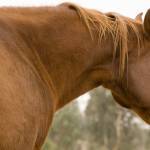Neuroaxonal Dystrophy in Horses

Neuroaxonal dystrophy (NAD) is a degenerative central nervous system disease of horses, humans, and other animals. Horses affected with NAD usually appear dull or depressed with weakness and mild to severe gait abnormalities (ataxia) that affect all four limbs, though the hind limbs are usually more severely affected. Clinical signs of NAD are usually first observed in young horses (two years of age or less). Neuroaxonal dystrophy is believed to be a heritable trait when pedigrees were analyzed in Morgans, Appaloosas, and Quarter Horses.
Neuroaxonal dystrophy is similar to equine degenerative myelopathy (EDM). Both diseases cause degenerative changes in the central nervous system. Differences between NAD and EDM depend on what specific areas of the central nervous system are affected. Vitamin E deficiency is associated with both NAD and EDM. Horses affected with NAD on a farm in California had variable serum vitamin E concentrations and nutritional analysis showed that vitamin E concentrations in grass were low. Vitamin E supplementation and selective breeding reduced, but did not eliminate, cases of NAD in following years. Research is in progress to develop a genetic test for horses that carry genes to transmit NAD to their offspring.
Important rule outs for young horses with gait abnormalities include cervical vertebral malformation (wobblers), equine protozoal myeloencephalitis (EPM), EDM, and central nervous system or spinal trauma. Diagnostic testing can include neurologic examination, radiographs of the vertebrae of the neck, spinal tap, and measurement of vitamin E in the blood and diet. Several equine neurologic diseases, such as NAD, EDM, and equine motor neuron disease (EMND), have been shown to be caused by vitamin E deficiency or to improve following vitamin E supplementation. Many veterinarians will include vitamin E therapy in their treatment of equine neurologic disease for its neuroprotective effects and for its role in preventing or reducing the clinical signs of degenerative nervous system disorders.








